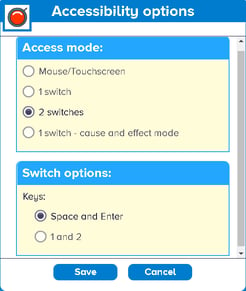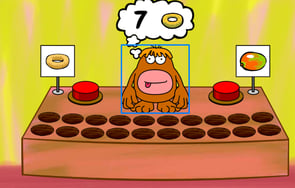Guest blog post written by John Galloway (Inclusion and Technology Advisory Teacher, Tower Hamlets)
When we think of a ‘switch’ we tend to think of a  means of turning something on and off, which is a starting point for how we might use the type of switch we refer to when it comes to assistive technology (AT) or assistive and augmentative communication (AAC). These switches are often, but not always, a button that brings a response when pressed.
means of turning something on and off, which is a starting point for how we might use the type of switch we refer to when it comes to assistive technology (AT) or assistive and augmentative communication (AAC). These switches are often, but not always, a button that brings a response when pressed.
They are often found in use with children and young people with more challenging and complex special educational needs and disabilities (SEND) to help develop a sense of cause and effect. A switch may be attached to a toy so when it is pressed it activates, or, depending on the learner’s sensory preferences, to a device such as a light, a fan, a massage pad, an audio player, or even a foot spa. The intention is to provide a rewarding response to the action of pressing the switch, thereby encouraging repetition.


But switches aren’t just for pupils we might describe as having severe learning difficulties (SLD) or profound and multiple learning difficulties (PMLD). They are a useful support for a wide range of people with access needs. Stephen Hawking is probably the most famous person who has been a switch-user. Without his system, he wouldn’t have been able to write his books or deliver his lectures. Although this was a complex set up, the basic principal was still a click at the right moment.
For many other users, switches are a technology that provide similar support, controlling grids of words, or on screen keyboards, to provide a means of communicating. However, they can also provide curriculum access in other ways, too. In some activities, multiple choice perhaps, they are a means of choosing an answer, in others, creating on-screen art, for example, they allow control of the colours and tools in use.
There are several activities of this sort available in Busy Things. When you open the Search panel you will find two options at the bottom: “Switch Scanning” and “Switch Cause and Effect”. These discriminate between the two principal ways of using them. The “Switch Scanning” option has a focus which moves around the screen. Learners can either use one button to select (with the focus moving automatically), or two buttons with one to select and one to move the focus. The “Switch Cause and Effect” option has no focus, and any button presses will simply trigger an on-screen reaction.

The range of activities available in Busy Things include maths, music, art and problem solving. The input options can be selected by clicking the Accessibility Options button. This can be found on the start activity popup, in the teacher toolbar (in Teacher Mode), or in the left column (in Pupil Mode). As with all the site’s activities, other settings can be changed, too, such as the number range in maths ones, to tailor them for the needs and abilities of learners.
Perhaps the most important thing switches offer, is a chance for children and young people to work independently, without the need of an adult, or a classmate, to control the computer for them. They can directly access curriculum content, just like everyone else. A good example of technology enabling inclusion.
Remember, if you need any support with our learning content you can contact the Inspire Team by emailing contentsupport@lgfl.net or contact the LGfL Switchboard: 020 82 555 555. Also visit coronavirus.lgfl.net which is continually updated with advice and support during the partial school closures.
If you do use any LGfL content in your school to inspire your students do let us know by posting them on LGfL’s Twitter or Facebook